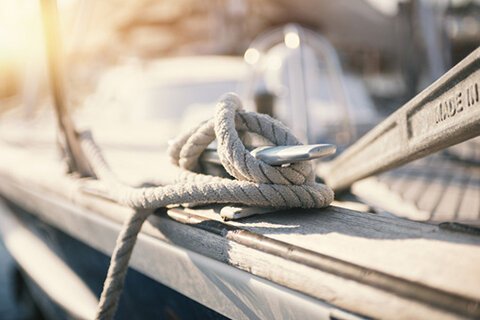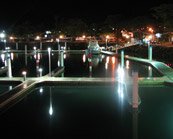Due to the nature of using the wind for power, a sailboatâs hardware endures a lot more stress and strain than a powerboat of comparable size. Over the years, all this hard work takes its toll and things start to wear out or failânot a good thing.
Â
Fasteners
Starting with one of the fundamental topics, letâs take a close look at what actually holds all those pieces of hardware in placeâfastenersâor more precisely, the bolts, nuts, and screws that keep everything together.
Â
On a boat, the fasteners should be made of a marine-grade stainless steel. Stainless steel fasteners donât rust or corrode like the nuts and bolts you might use around the house.
Â
When you attach hardware to the deck, you should thru-bolt the item. Thru-bolting means drilling a hole in the mounting surface, and using a long bolt that goes all the way through the piece of hardware, through the mounting surface, with sufficient bolt threads exposed on the underside so you can put a washer and nut on.
Â
Thru-bolting can be kind of a pain, but donât take the easy way out and use sheetmetal screws to fasten anything of importance to your boat. The screws will pull out under the slightest strain.
Â
Railings
One of the most common areas of sailboat hardware concern deals with the boatâs rails and the rail fittings that secure the rails to the boat. Over the course of several years, the rail fittings have a tendency to work loose, becoming wobbly when you lean on them.
Â
Â
This situation can often be resolved by re-tightening the fasteners at the base of each rail fitting. Take care not to mar the bolt heads during this processâdamaged bolts can be a major chore to remove.
Â
If re-tightening the rail fittings doesnât do the job, youâll have to replace the old fasteners with new ones (re-fastening, in nautical-speak). Hereâs a tip: put some marine sealant on each bolt shank before you push it through the deck. The sealant can help to keep water from seeping in. Adding a drop of thread sealer to the bolt prior to starting the nut will ensure that the nut doesnât come off until you want it to.
Â
Lines
You should also be aware that the lines that make up your sailboatâs running rigging arenât infallibleâlines deteriorate with age, making them weak and prone to failure at the most inopportune time.
Â
If your lines are suspect, nowâs a good opportunity to consider an upgrade to new ones.
Â
Two of the most common types of line are: three-strand and braided. Due to the fact that nylon three-strand line stretches quite a bit, most sailors use it for anchor or dock lines.
Â
Braided lines, as the name implies, consist of multiple fibers braided together. Single braid lines donât have an outside covering, making them very flexible. Double braid lines feature a braided cover over a braided core, making them the line of choice for running rigging.
Â
Replacing your lines isnât really an expense; itâs more of an investment in future boating pleasure.
Â
Looking Ahead
Maintaining your sailboatâs hardware requires a little extra time, and more often than not, a bit more effort in order to do things rightâbut itâll be worth it in the long run.
Â
Â
Â



